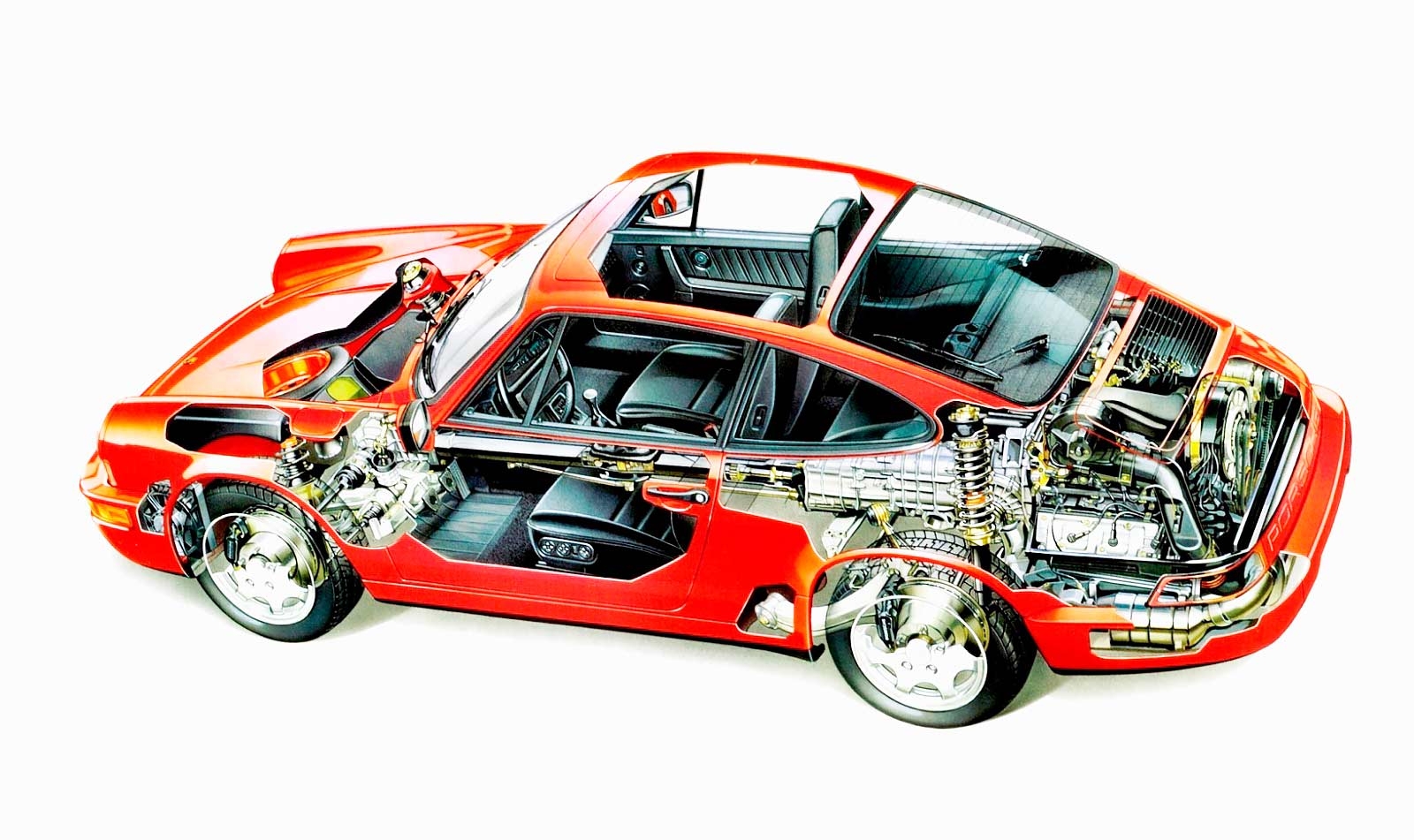
Porsche All-Wheel Drive Evolution Last month we examined Porsche Stability Management, here we look at the evolution of its all-wheel drive system, which celebrates its 30th anniversary in 2018…
In 1947, Porsche developed the Type 360, better known as the Cisitalia racing car. It became legendary not only because of its twelve-cylinder supercharged engine and lightweight construction throughout, but also because of its part time all-wheel drive. This design was again based on the idea that, on bends or on road surfaces with low coefficients of friction, drive power can be fully and safely transformed into propulsion.
In 1981, Porsche began using all-wheel drive for nonracing cars. At the International Motor Show in Frankfurt, the company presented the study of a 911 Turbo Cabriolet with all-wheel drive. In 1984, Porsche revisited the idea and designed the 953 with part time all-wheel drive for the Paris-Dakar Rally, at which it promptly took overall victory. Experiences with the 953 led to the 959 super sports car being manufactured; it was launched in 1985 and was really ahead of its time in terms of its overall technology. With front-wheel drive that engaged via a multi-plate clutch and a rear differential lock also actuated via the multi-plate clutch, it created the basic concept for the Porsche all-wheel drive system. These center-differential lock and rear differential locks were actuated both manually and automatically. The concept is still a feature of PTM today. The double victory of the 959 at the 1986 Paris-Dakar Rally became legendary.
911 CARRERA 4
When Porsche presented the 964 in 1988, a number after the model designation heralded a new era: the 911 Carrera 4 was the brand’s first series-production sports car with all-wheel drive – and it featured a pioneering new design. Porsche called the innovation a ‘differential slip-controlled’ drive across all four wheels. This means that drive torque is first transmitted from the manual transmission to a longitudinal transfer case designed as a planetary gear set; from there, provided the lock control is not enabled, it is always split in the same ratio: 69 per cent for the rear axle, and 31 per cent forwards via an enclosed transaxle shaft.
The manner of adjustment was innovative. Slippage at individual wheels was detected by the car’s ABS sensors and prevented by hydraulic locks. Two electronically controlled multi-disc locks controlled the flow of forces to the front axle and between the wheels of the rear axle. The effect: permanent optimisation of traction and driving stability, handling on bends, and load change response.
1994: VISCOUS COUPLING
In 1994, Porsche resumed development of its all-wheel drive system with the 993 Carrera 4. The 911 Turbo now also used all four of its wheels to transmit power for the first time. With both models, Porsche switched to a simpler system design, which helped it to launch the lightest all-wheel drive system on the market at that time. The system was designed as a hang-on all-wheel drive, with the rear axle being directly driven and, in the event of speed differences between the front and rear axles, a passive viscous coupling that transmitted some of the propulsion force to the front axle. So the viscous coupling replaced the transfer case and controlled the multiplate clutch for the front axle’s drive. As a result, the all-wheel drive 911 was effectively dominant to the rear when under load, in a similar way to a rear-wheel drive but much more stable. A conventional differential lock and an automatic brake differential (ABD) were used on the rear axle.
The role of the viscous coupling was to automatically distribute drive torque between the axles, depending on slip at the rear wheels. The ABD built into the all-wheel drive model as standard used ABS sensors to detect the slip at the individual wheels and provided a corresponding braking torque at the spinning wheel via the control unit. With different coefficients of friction on the right and on the left, the propulsion force was initially moved continuously by the rear axle differential lock to the wheel with increased power transmission. If a wheel began to spin, it was decelerated by the ABD, and drive torque at the level of the braking torque was transmitted to the opposite wheel. This feature was particularly helpful to the driver when experiencing problems starting the vehicle on wet or slippery road surfaces.
Porsche stuck with this concept for the 996, the difference was that the viscous coupling ran in the oil bath of the front axle drive unit and was therefore effectively cooled even under high load. The transaxle tube was omitted from the 996 generation of 911 due to weight and in order to create space for the water cooling pipes. Instead of a rigid connection between the transmission fastened directly to the engine and the front axle drive unit (via a central tube), drive was supplied to the front axle via an exposed cardan shaft.
2002: CAYENNE INTRODUCES PTM
In 2002, Porsche presented the Cayenne – its third model line – and it featured completely new all-wheel drive technology. In basic mode, Porsche Traction Management (PTM) transmitted 62 percent of engine power to the rear wheels and 38 percent to the front wheels. However, using an electronically controlled multi-plate clutch operated by an electric motor as a variable centre-differential lock, it was possible to vary the distribution ratio according to the driving situation and so actively influence longitudinal and lateral dynamics. In addition, a rocker switch made it possible to manually engage a centre-differential lock for intensive off-road use.
PTM had a decisive influence on the driving dynamics of the Cayenne. The map-controlled centre-differential lock and an optional rear differential lock didn’t simply respond to a lack of traction at the front or rear axle. In addition, sensors also detected vehicle speed, lateral acceleration, steering angle and accelerator control, so that PTM was able to calculate the optimum degree of lock for both axles and assign the necessary drive torque to the axles. PTM was therefore a forward-looking system that delivered great agility when taking bends and excellent driving stability when changing lanes, both at high speeds and when driving more slowly on ice and snow.
2006: PTM FOR THE 911
In 2006, electronic PTM was used in a modified form in the 997 Turbo. Here, the core element was an electro-magnetically actuated multi-plate clutch that was used to transmit propulsion force to the front axle as required. The clutch of the 911 Turbo was designed for a peak torque of 295lb ft, which in practice almost never occurred: even at 220lb ft, the front wheels lost grip on dry road surfaces and began to spin.
With a maximum response time of 100 milliseconds, PTM responded more quickly to load change than the engine or the driver. In practice, this meant great agility on narrow country roads, outstanding traction and incredibly safe driving, even when carrying out extreme manoeuvres at high speed. In order to perform these dynamic driving tasks, Porsche’s designers programmed PTM with a set of key basic functions; to this day, the Porsche all-wheel drive still essentially works on these principles.
Firstly, basic torque distribution. In everyday driving, the control system continuously distributes engine torque between the front and rear axles in accordance with the current driving situation by engaging the front axle drive in a defined way. For this purpose, the torque required at the front axle is determined on a millisecond basis. If the system detects a lane change, for example, it engages the front-wheel drive to a greater or lesser extent based on the speed. The driver will experience this as a significant increase in stability, especially at very high speeds.
Second: guided control. Using typical parameters, PTM is able to detect dynamic changes to driving status at an early stage and avoid slip in advance. When starting the car, for example, the system determines how fast the driver is accelerating. Even before the engine can translate this request to accelerate into torque, the PTM locks the multi-plate clutch enough to prevent the wheels from spinning as much as possible. Only in extreme cases, such as when both rear wheels are grinding on sheet ice without any traction, is enough engine torque transmitted to the front wheels to cause them to spin. This means that, even when starting the vehicle, all four wheels are under the greatest possible propulsion force and optimum acceleration is achieved. An exception to this is a racing start via ‘Launch Control’ in conjunction with the PDK transmission. If this is required, PTM locks the multi-plate clutch before the vehicle is started in order to guarantee maximum traction.
SLIP CONTROLLER
Due to its high levels of torque, a 911 is able to reach its traction limit at the rear axle in a short burst of speed, especially on a wet road surface. More torque and therefore propulsion force is transmitted to the front axle through stronger engagement of the multi-plate clutch. It was in 2006, that the 911 Turbo first featured this detection and control of longitudinal acceleration.
Oversteer correction is another key basic function. If the rear end of the vehicle pushes outwards on a bend due to disruptive influences such as wet leaves, greater propulsion force is transmitted to the front axle in order to stabilise the vehicle in a dynamic way. A further benefit of PTM is the way in which the steering angle is taken into account when distributing power to the front axle. If the driver countersteers to correct an oversteer, PTM adapts the propulsion force to the front axle and the vehicles stabilises even more quickly.
Next we move to understeer correction. on the other hand, if the front wheels of the car are pushing out of the bend, PTM reduces the torque to the front axle. In both cases, PTM uses the precision sensors to respond before the driver has even noticed any instability. The result is fast, active stabilisation of the vehicle for efficient and dynamic driving on bends, as there are fewer braking interventions at individual wheels by the PSM stability system.
PANAMERA AND MACAN
PTM in the 911 became the master model for the all-wheel drive of the Panamera, which celebrated its world premiere in 2009, and of the Porsche Macan, which was launched as the fifth Porsche model line in 2013. Porsche Traction Management has continued to evolve with each new generation of both. In 2013, the focus with the new 911 was on increasing positioning accuracy as well as the torque that could be transmitted to the front axle. Since then, the system – which now features electro-hydraulic actuation of the newly developed multi-plate clutch – has been able to identify an economical style of driving based on the situation and the driver’s requirements, it reduces transmission of drive torque to the front axle where necessary.
This reduces overall power dissipation. PTM also supports coasting that is characteristic of Porsche, in conjunction with the PDK transmission. The PTM clutch will open if the vehicle is coasting without drive. So the all-wheel system reduces braking torque and therefore also fuel consumption. The latest PTM also brings performance benefits. There are improvements in terms of driving dynamics, agility and driving stability thanks to faster and more precise control of propulsion force via the new multi-plate clutch. Acceleration is improved by transmitting higher torques over the front axle, which allows the increased engine power to be transferred to the road also.
2013: MACAN TURBO
The latest version of Porsche’s PTM system used in the latest models is the very embodiment of sporty all-wheel drive. Its intelligent nature improves agility on bends, stability when performing highly dynamic manoeuvres, and traction. PTM represents the current pinnacle of how all-wheel drive has evolved in Porsche series-production sports cars over more than 30 years.
Porsche all-wheel drive has its roots in motor racing. In 1984, it helped the 953 to win the Paris- Dakar Rally; in 1986, the 959 super sports cars with electronically controlled variable all-wheel drive celebrated a double victory. Now it helps keep Porsche’s SUV in check.
TIMELINE: ALL-WHEEL DRIVE DEVELOPMENT
1988: World premiere of the electronically controlled all-wheel drive in the 911 series-production model. The first 911 road car with all-wheel drive as standard celebrated its world premiere in 1988. The 964 Carrera 4 used a planetary gear set as a centre differential to distribute propulsion force. In addition, multi-disc locks were placed between the front and rear axles (as a centre-differential lock) and on the rear axle (as a controlled differential lock).
1994: Second generation with passive hang-on system. Porsche presented its second-generation all-wheel drive in 1994, in the 993. The system was constructed as a hangon all-wheel; if there is a difference in speed between the directly driven rear axle and the front axle, a passive viscous coupling transfers some of the propulsion force to the front axle. This system was transferred virtually unchanged for use in the 996 Carrera and 996 Turbo models.
2002: Porsche Traction Management premieres in the Cayenne. The era of Porsche Traction Management began in 2002 with the Cayenne. At this point, PTM was a permanent all-wheel drive system with a central transfer case that distributes propulsion force to the front and rear axles at a ratio of 38:62. In addition, a reduction gear and an electronically controlled centre-differential lock deliver full off-road capability, as you would expect for an SUV. The first PTM also impressed with its driving dynamics capabilities.
2006: The first 911 with PTM. In 2006, with the 997 Turbo, Porsche presented a version of PTM that had been enhanced specifically for use in its sports cars; it featured an electronically controlled and electro-magnetically actuated multi-plate clutch with ball ramp reinforcement. This active, fully variable system distributes propulsion force between the permanently driven rear axle and the front axle much more quickly and accurately than the passive viscous coupling used in the previous version. In 2008, this system was also used in the 911 Carrera 4 models of the second-generation 997; in the first-generation, they still had the all-wheel drive with viscous coupling.
2009 and 2013: Panamera and Macan with 911 technology. The all-wheel drive variants of most Panamera models (from 2009) and all Macan (from 2013) also have a controlled multi-plate clutch. The control strategy is based on that of the 911 and as such helps to ensure that the Panamera and Macan deliver best-in-class driving dynamics that are more typical of a sports car rather than an SUV.
2013: Latest PTM – even more efficient. The latest, most advanced, version of PTM was first put to use in 2013 in the first-generation 991 Turbo. In contrast to the previous system, which was used with the 911 Carrera 4 models right up to the second-generation 991 in 2015, the newly developed multi-plate clutch is now controlled electro-hydraulically rather than electro-mechanically. This has advantages in terms of performance thanks to faster and more accurate control of propulsion force in relation to traction, driving stability and the car’s overall handling characteristics.





